|
Brecon, South Wales 24th February 2001
| Early in the morning of Saturday,
24th February, my partner Judy and I set out from the South Coast
in the direction of South Wales and the famous town of Brecon. which
lies in the midst of the Brecon Beacons, where the SAS and other British
Army regiments prepared for the Falklands war. We were going to watch
the uniformed members of the 1879 Group march through the town together
with a detachment of the Powys Army Cadet Force and their Corps of
Drums . The parade was to begin at Brecon Cathedral, (which houses
the regimental chapel of the 24th) at 3pm and the journey up from
the New Forest where we live would take a good three hours. Going
home to Wales is always a very special thing for me and I am sure
that any expatriate from any nation will understand that increased
feeling of patriotism and nationalistic identity that is generated
by living somewhere other than with your "own people". We had therefore
wanted to arrive at Brecon in plenty of time to meet old friends amongst
the members of the 1879 Group and to bask in the warmth that is generated
so naturally and abundantly by Welsh people. We arrived just before
midday and watched both the Cadet Force and the 1879 Group members
practising their drill before the big event. |
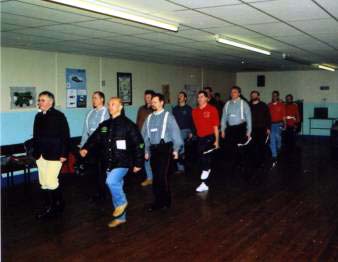
1879 Group practise their drill before the parade
|
The parade, is an annual fund raising event, and is organised by the Brecon
branch of the Royal Regiment of Wales Comrades Association (the 24th having
been amalgamated into the Royal Regt of Wales) to mark the infamous defeat
of the regiment at Isandlwana and the heroic defence of Rorke's Drift
on 22nd / 23rd January 1879 .It was a huge honour for the members of the
1879 Group to have been invited to march through the streets of the town
which is the Regimental home of the famous 24th Foot, and whom they portray
as re-enactors. We left the group to their drill and went to visit the
Regimental museum which is housed in the oldest building in the Brecon
barracks complex . It is a truly wonderful little museum, absolutely crammed
with uniforms, arms and accoutrements, letters and paintings detailing
the history of the Regiment from 1689 until its amalgamation with the
Welch Regiment in 1969, and then onwards as the Royal Regiment of Wales.
The Zulu War period is a very popular, perhaps the most popular, period
in the entire Victorian almanac and many books and two notable films -
Sir Stanley Baker's "Zulu" and the later "Zulu Dawn" have fuelled much
interest. Nowadays, visitors come from far and wide to see the great collection
of artefacts in the museum's Zulu War Room.
After our visit to the museum it was time to walk to the top end of Brecon
town, where we took up position at the bottom of the hill leading up to
the cathedral. There we waited with our cameras until the sounds of a
military band told us that the march was under way and approaching. The
march was led by the cadet Corps of Drums followed by the 1879 Group comprising
mostly of 24th re-enactors of various ranks, but also including some members
wearing the uniforms of the various South African regiments who also took
part in the war. Much energetic backward running in front of the parade
produced some of the pictures which accompany this article and I hope
they will convey some of the atmosphere of the day.
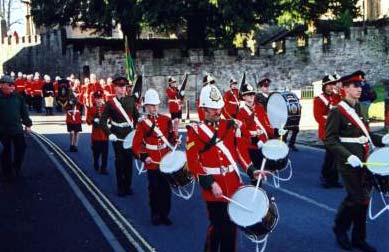 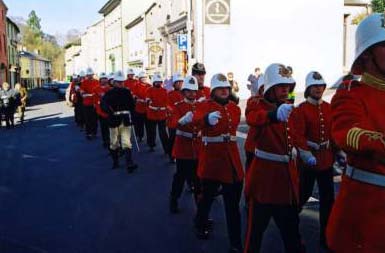
|
Powys Cadet Corps of Drums and Colours
|
Marching into the town of Brecon
|
After their march through the streets of Brecon, the 1879 Group and the
cadets assembled in the playing field alongside the canal for a photo
session. Duncan MacDonald, a museum committee member and a Colour Sergeant
with the Cadet Corps, wanted to try and recreate the famous C.E.Fripp
painting of the 24th's last stand at Isandlwana.
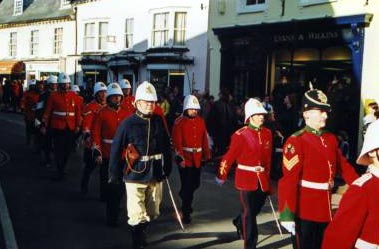
1879 members marching through the town where the 24th have marched
before

1879 Group re-creation of 24th's last stand
The result of his efforts and a copy of the original painting
may be seen below.
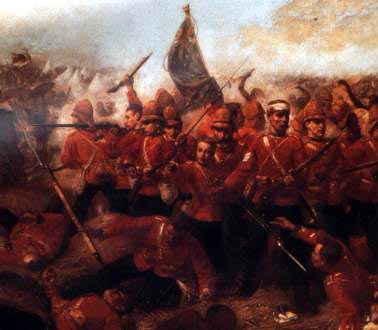
A section of C.E.Fripp's painting of 24th 's last stand at Isandlwana
Photos were also taken on the canal bank in front of some of the cottages
where one of the casualties of Isandlwana once lived. At the end of the
day members of the group went to the museum where they answered questions
from interested members of the public.
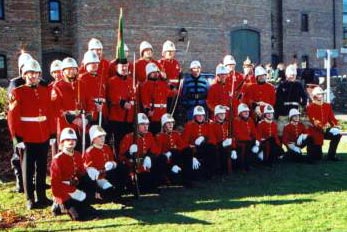
1879 Group and Powys Army Cadets
|
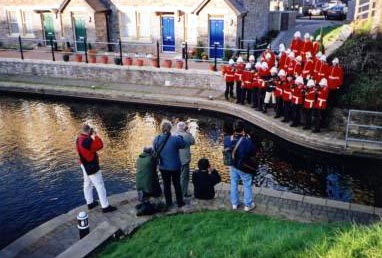
A photo shoot on the canal bank
|
Judy and I travelled on the short distance to Hay, the famous "town of
books", where we spent the next day, Sunday, looking for out of print
Victorian uniform reference books. I found several that I did not already
have, but that's another story...
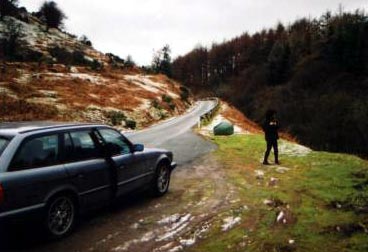
The Welsh hills above Brecon
The 1879 Group
In 1963 when Maurice Jones was a lad of 11, he used to help his father,
who was the projectionist at the Celtic cinema in Aberystwyth, by rewinding
the spools of film after they came off the projectors. One night the cinema
was showing the film "Zulu" and that particular film had such an effect
on the young Mo that, as he says, "ever since that night my life has been
taken over by the subject"
Twenty-three years later, in September1996, he realised his dream and
went to Kwa Zulu Natal in South Africa and over a period of ten days visited
all the battlefields of the Zulu W
ar of 1879.A highlight of his visit
was his meeting with Prince Buthelezi , (see photograph below)
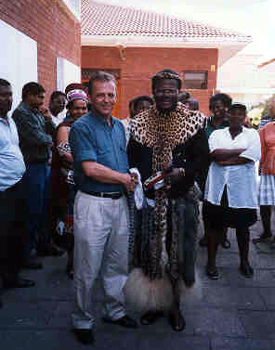
Mo Jones and Prince Buthelezi in 1996
At Brecon Barracks in May 1998 there was a meeting for any descendants
of the eleven men who were awarded the Victoria Cross for their valour
at Rorke's Drift .The meeting was also open to anyone interested in the
exploits of the 24th Regiment of Foot during the Zulu War. I am proud
to say that I was present at that meeting when the 1879 Group was born.
It has been almost entirely due to Mo's efforts that the Group now numbers
223 members including upwards of 60 who form the Living History section.
Most of the members of this section wear the uniforms of the 24th. but
other regiments who took part in the Zulu War are also represented, together
with a small group of ladies who wear the costume of the period . Typical
campsites are displayed and manned at many events over the season to show
the public how the soldiers of 1879 lived whilst on campaign.
The 1879 Group have a unique friendship with the Zulu people through
His Excellency Prince Mangosuthu Buthelezi, great grandson of King Cetshwayo
KaMpande, King of the Zulu nation in 1879 (King Cetshwayo was finally
captured by an office
r of another Welsh regiment - Major R Marter, 1st
Kings Dragoon Guards) Prince Buthelezi is the patron of the 1879 Group.
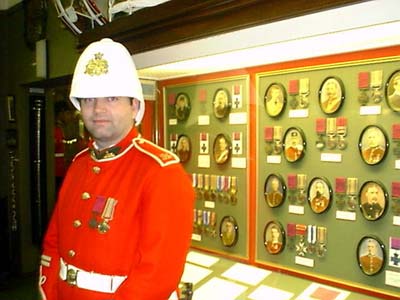
Mr John Roberts - ( President of the 1879 Group and Great Great Grandson
of Private 593 William Jones VC.
Chairman of the 1879 Group is John Roberts, pictured above. He is the
great great grandson of 593 Private William Jones VC. Another member is
Henry Bunting, now in his eighties, who is the grandson of Alfred "Henry"
Hook VC. It must be stated that Mr Bunting has always deplored the inaccurate
portrayal of his grandfather in the film "Zulu"
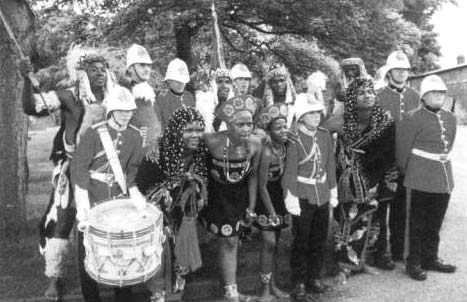
A group of Zulu singers and dancers add to the Group's attractions.
Keith Perks Thin Red Line
The 1879 Group would like to recruit more members of African origin who
would be willing to research and present their own living history in conjunction
with the group.
Membership is open to anyone with an interest in the Zulu War.
A life-membership fee of £10 is payable on joining with an additional
£10 per annum for re-enactors.
All enquiries to Founder and Membership Officer:
Maurice Jones
Trewern
Talybont
Cardiganshire
SY24 5EY
UK
Tel. (+44)1970 832378
Email Mo1879@thedrift.swinternet.co.uk
Site: The
1879 Group
Back

Thin
Red Line
Thin Red Line,
PO Box 65,
Seavington,
Ilminster,
TA19 0WE. UK
|
![]()